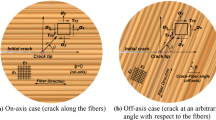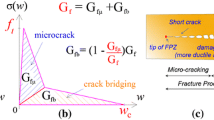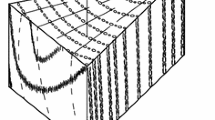Abstract
The characterization of Mixed Mode (Mode I and Mode II) behaviour of wood was concentrated on concepts of linear fracture mechanics in the past. Using an adopted version of the splitting test it was possible to obtain complete load displacement curves under different Mixed Mode loading cases for crack propagation along the grain. Therefore fracture energy concepts (specific fracture energy) could be used to characterize the material behaviour. Additionally strength parameters were used in order to describe crack initation in two crack propagation systems. The values for specific fracture energies as well as the strength values were compared with pure Mode I fracture tests. Moreover, the size effect under Mixed Mode loading was investigated to guarantee size independent material characterizing values for the specific fracture energies.
Similar content being viewed by others
References
M. F. Ashby, K. E. Easterling, R. Harrysson and S. K. Maiti, Proc. R. Soc. (London) A 398 (1985) 261.
G. Prokopski, J. Mater. Sci. 28 (1993) 5995.
S. E. Stanzl-tschegg, D. M. Tan and E. K. Tschegg, Wood Sci Technol. 29 (1995) 31.
L. Daudeville, Holz als Roh-u. Werkstoff 57 (1999) 425.
C. L. Chow and C. W. Woo, in Proc. 1st Internat. Conf.Wood Fracture (Vancouver, 1979) p. 39.
J. G. Williams and M. W. Birch, in ASTM STP 601 Cracks and Fracture, p. 125.
J. D. Barrett and R. O. Foschi, Eng. Fract. Mech. 9 (1977) 371.
S. Mall, J. F. Murphy and J. E. Shottafer, J. Eng. Mech. 109 (1983) 680.
G. Valentin and P. Caumes, Wood Sci Technol. 23 (1989) 43.
A. P. Schniewind, S. L. Quarles and S.-H. Lee, ibid. 30 (1996) 273.
S.-H. Lee, S. L. Quarles and A. P. Schniewind, ibid. 30 (1996) 283.
E. K. Tscheggand S. E. Stanzl tschegg, Austrian Patent Office, registered Nov. (1999).
E. K. Tschegg, T. Pleschberger and S. E. Stanzl-tschegg, Int. Journ. Fract., submitted.
E. K. Tschegg, Aust. Pat. 233/96, 390 328 (1986).
A. Reiterer, S. E. Stanzl-tschegg and E. K. Tschegg, Wood Sci. Technol. 34 (2000) 317.
G. Sinn, A. Reiterer, S. E. Stanzl-Tschegg and E. K. Tschegg, Holz als Rohund Werkstoff, accepted.
S. Holmberg, K. Persson and H. Petersson, Comp. Struct. 72 (1999) 459.
A. Hillerborg, Int. Journ. Fract. 51 (1991) 95.
S. Holmberg, Report TVSM-1010, Lund University, 1998.
A. Hillerborg, Rilem Techn. Committees 18 (1985) 292.
H. Harmuth, K. Rieder, M. Krobath and E. K. Tschegg, Mater. Sci. Eng. A 214 (1996) 53.
V. E. Saouma and E. S. Sikiotis, Eng. Fract. Mech. 25 (1986) 115.
H. Schachner, A. Reiterer and S. E. Stanzltschegg, J. Mater. Sci. Lett. 13 (2000) 1783.
J. Bodig and B. A. Jayne, in “Mechanics of Wood and Wood Composites” (Krieger Publishing Company, Malabar, 1993).
Author information
Authors and Affiliations
Rights and permissions
About this article
Cite this article
Tschegg, E.K., Reiterer, A., Pleschberger, T. et al. Mixed mode fracture energy of sprucewood. Journal of Materials Science 36, 3531–3537 (2001). https://doi.org/10.1023/A:1017940903011
Issue Date:
DOI: https://doi.org/10.1023/A:1017940903011




